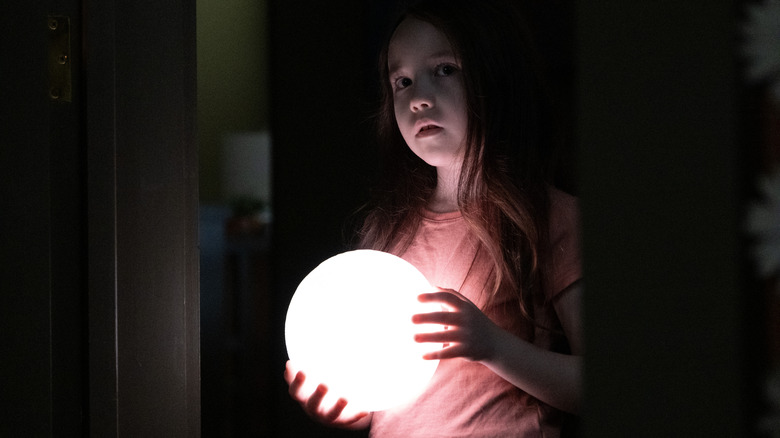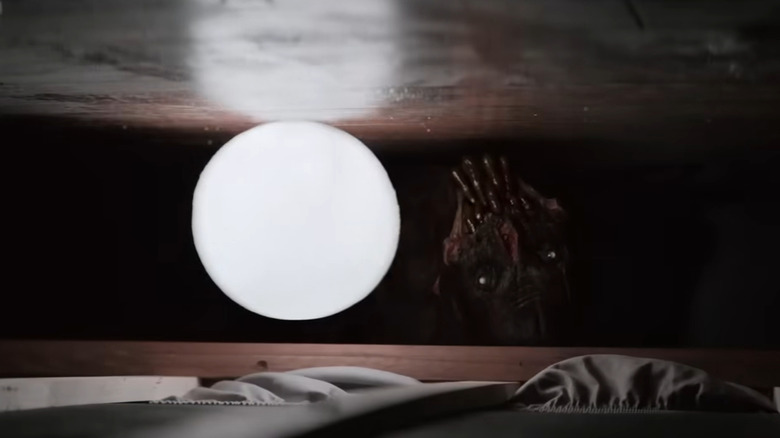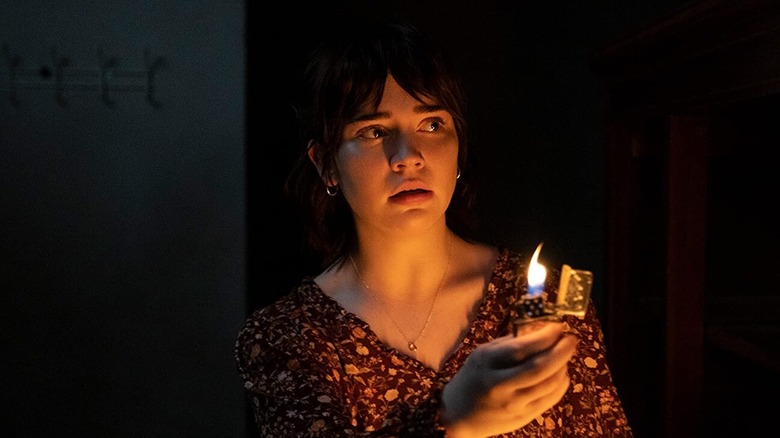The Boogeyman Director Says The 'Lovecraftian' Design Of The Title Creature Honors Stephen King's Original Short Story [Exclusive]
This post contains spoilers for "The Boogeyman."
Don't look now, but I think there's a metaphor for grief loose in the house.
Rob Savage's new film "The Boogeyman," based on a 1973 short story by Stephen King, leans hard into a familiar trope of the current generation by focusing on a monster (the titular "man") who's quite clearly a symbol for grief and trauma. In the movie, the death of a family's matriarch leaves her husband (Chris Messina), teenage daughter (Sophie Thatcher), and younger daughter (Viven Lyra Blair) with a grey, lingering hurt. As they try to work their way through mourning, a mysterious creature begins appearing out of the shadows. The monster can imitate human voices and lure victims into closets where they will be rend to pieces. The creature has been traveling from house to house, drawn to places of sadness, eating children and driving adults to take their own lives.
Because the creature lives in the dark, there aren't a lot of clear shots in Savage's film of what it looks like. It's vaguely humanoid but seems to have elongated, spider-like limbs. It has a large face and crab legs where its mouth ought to be. It moves quickly and is very strong, easily able to hurl victims bodily against the wall. It's an animal and it bleeds, but it's also clearly supernatural. In that regard, it's a lot like the clown spider in "It."
Also like in "It," a character posits that the Boogeyman might be an ancient cosmic evil that predates the evolution of life on Earth. It's like something out of an H.P. Lovecraft story.
/Film's Ben Pearson recently spoke with Savage, and the director wanted that Lovecraftian influence to be seen in the creature's design. In short, it was meant to be too horrible for the imagination to encompass.
Fear of the unknown
H.P. Lovecraft, a reclusive horror author from Rhode Island, famously wrote stories about monsters so large and bizarre that merely glimpsing them could cause people to experience a psychological breakdown. He constructed an entire pantheon of uncaring deities that merely awaited being released from a millennia-long prison sentence so that they could once again take their spot in the cosmos and lay waste to human life. They weren't so much evil as they were indifferent to humankind. A lot of Lovecraft's language is devoted to how ineffable and unknowable the deities are.
Rob Savage wanted to communicate that sense of Lovecraftian largesse, making his monster something that the audience will not be able to see or understand entirely, at least not during the first half of the movie. He also likened his approach to another famous monster story from the 1970s. In his words:
"I wanted it to feel like there was an unknowable quality to this creature. For a large part of the movie, we were just doing the fin above the water in 'Jaws.' We weren't really showing this creature. It needed to be kind of stark and striking, but mostly it needed to bleed off into the shadows and be something that the audience could use their imagination to fill in the rest. Then when you finally see the creature, the idea was that you're going to see it, so we are going to fulfill the mandate of this being a big Friday night popcorn horror movie."
That meant that, like in "Jaws," audiences would eventually have to see the monster clearly, or at least clearly enough to watch the film's characters fight it to the death. The obfuscation is effective, but has to end at just the right time.
Jaws vs. Cthulhu
Rob Savage found it was a balance between keeping the monster unseen and ineffable like in an H.P. Lovecraft story, but still allowing it to be a classic, exploitation-style movie monster. One has to be scared of it, but also cheer when it gets thwacked by the film's leads. It has to be both seen and unseen. Savage explained:
"You want to see the monster, you want it to fight our lead character, but also it's going to reveal some Lovecraftian depth to it that's ultimately going to kind of set your mind on fire and think that you've only seen a fraction of what this thing truly is."
There was even a reason why it appeared that the Boogeyman had claws, fingers, and appendages in its mouth area. Savage led in, saying:
"It was really our attempt to one, kind of building in this reveal whereby this kind of grinning toothy look that we've seen throughout the rest of the movie is revealed to be knuckles and fingers that then come out and reveal this inner self. [...] [I]t was an homage to the short story, which ends, of course, with the therapist character peeling off its skin and revealing to be the boogeyman within. It was our way of honoring that."
Without revealing too much, the ending of the movie is much different from Stephen King's short story. But it seems the monster still bore that subtle homage. The symbolism of "The Boogeyman" may be straightforward, but the monster is first-rate.
"The Boogeyman" is now playing in theaters.


